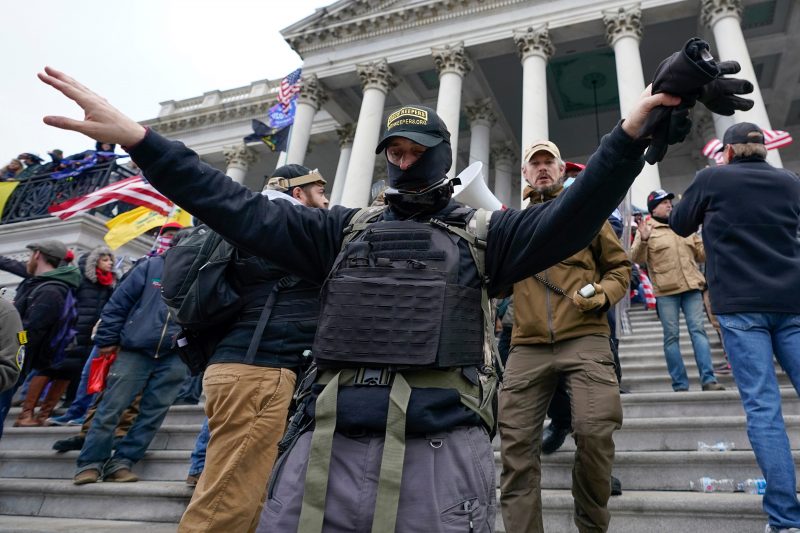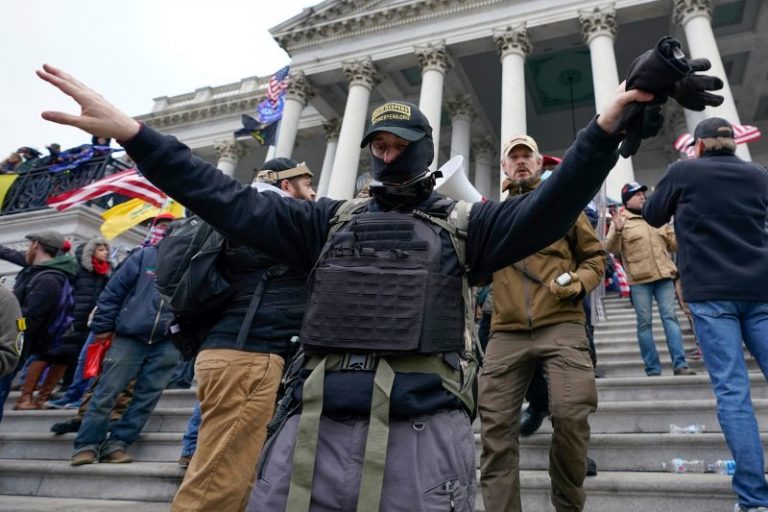
It is unquestionably true that from January 2017 to January 2021, there was a cottage industry selling the promise that President Donald Trump’s tenure in the White House would soon be coming to a close.
There was real reason to think that Trump might face negative outcomes for his embrace of Russia’s efforts to swing the 2016 election in his favor, for his attempt to leverage U.S. aid to Ukraine to benefit his reelection or for any number of other politically toxic actions. But factual reporting on Trump and his administration sat alongside podcasts and social media accounts that generated audiences and, often, income by pledging that Trump’s demise was always one new revelation away.
In part because critical coverage of Trump was conflated with opposition to him, these explicitly anti-Trump efforts became part of a narrative about institutions, particularly in the media, chasing shadows in their eagerness to see the president crumble. The incorrect idea that investigations into Russian interference in the 2016 election yielded nothing impugning Trump is rooted both in a lack of familiarity about the outcomes of those investigations and on the idea that everything involved in those investigations was a hype job aimed at leveraging anti-Trump sentiment.
Since even before Trump left office, though, the right was also chasing shadows — with elected officials and the right-wing media leading the charge.
Late last month, House Speaker Kevin McCarthy (R-Calif.) granted access to surveillance footage from the Capitol riot to two Trump-sympathetic writers: fervent Capitol-rioter defender Julie Kelly and John Solomon of Just the News, whose uncritical coverage of claims made by Ukrainian officials was at the center of Trump’s 2019 impeachment. McCarthy had already given access to Tucker Carlson, back when Carlson commanded millions of viewers a night on Fox News.
In each case, it’s safe to say, McCarthy was seeking to build a stronger relationship with the right-wing media ecosystem, using Capitol video footage as a chit. Since shortly after the riot, after all, there were frequent calls for the surveillance footage of the day to be released.
It wasn’t that it was known that the footage would somehow reshape the obvious reality of the day — that is, that scores of people engaged in violence against police officers and stormed into the Capitol to block the finalization of Trump’s election loss and Joe Biden’s win. It was, instead, that the footage might in some hard-to-conceive way reshape that reality — and the fact that the government wasn’t releasing all of the footage was evidence that clearly some of it did threaten to do so. People such as Kelly herself called for the footage to be released as she tried to sow skepticism about what the rioters did.
So McCarthy handed over the footage. Carlson, who had similarly been trying for months to cast the government as the bad actors on Jan. 6, did his best to sow doubt about the day’s events. What resulted was, instead, an effort to inculpate the guy he had long been claiming was a government agent (despite voluminous evidence to the contrary), exculpate the actions of the “QAnon shaman” and elevate one of the oldest efforts to play down what happened by focusing on all of the people who weren’t rioting that day.
No bombshell. No revelation of something hidden. Just incremental stuff that he aired in one show, and that was it. But all the video still hadn’t been released, so there were still calls to release it, and so now Solomon and Kelly get their turns to take a bite.
Amusingly, Kelly very quickly joined team “we can’t release it all” once she was granted access, arguing, as the government had all along, that doing so was an enormous technological challenge. She also expressed concerns about security — not the security risk of exposing where cameras were located and what measures are in place in the Capitol, as had been articulated in the government’s reticence to release it all, but the security of various other rioters who might be picked out of footage by the community of amateur sleuths that’s been effectively identifying violent actors.
Sedition Hunters would spend every second of every day analyzing the videos in order to hunt innocent people that just stood on Capitol grounds on J6.
Look at how upset they are Julie Kelly got to view the J6 tapes they so desperately want in order to doxx and destroy people. https://t.co/pIxzWSFBfJ
— Marjorie Taylor Greene  (@mtgreenee) June 2, 2023
(@mtgreenee) June 2, 2023
It’s been a week since the world learned that Solomon and Kelly would get access to the tapes. In an interview Friday, Kelly said that Solomon, who got access earlier, was “going to have some really bombshell revelations in the next several days here on key controversies of that day.”
So what has he reported?
That then-House Speaker Nancy Pelosi was evacuated from the Capitol “Hollywood-style”That footage shown during hearings run by the House select committee investigating the Jan. 6 riot overlaid audio onto silent surveillance footage, andThat a door into the Capitol was opened and left open, something first reported in October 2021.
The first two stories from Solomon — picked by Trump last year to be one of two representatives authorized to access his records with the National Archives — are focused almost entirely on stoking right-wing anger about the riot. (The other representative, former Trump administration official Kash Patel, is cited in one of Solomon’s reports wringing his hands about the whole affair.) The third story comports with Carlson’s goal, suggesting that there were people in the Capitol who didn’t necessarily commit acts of violence to be there, something that has been understood since about 4 p.m. on Jan. 6, 2021. Those imprisoned for their role in the day are not understood to have come from that pool of people.
Kelly has not yet released any reporting after reviewing the video, but in multiple interviews she has suggested that she’s seen compelling stuff.
“I have seen some alarming footage that has not been made available to the American people,” she said in an interview published Thursday. “And without getting too ahead of myself, or getting ahead of the other reporters who are going to be presenting their clips and their stories, I will say, as we’ve said all along and you and I have talked about, the media’s narrative, the Biden narrative about what happened it just simply is not factually correct.”
Why? Well, because “the idea … that police behaved heroically that day simply does not match up to the footage.”
“No matter how hard it is for our side to admit that police acted badly,” she continued, “they certainly did for the most part, and this is one huge angle of Jan. 6 that needs to be told to the American people.”
More than 100 people have been charged with using a deadly or dangerous weapon or injuring police during the riot. About 140 officers were injured, many seriously.
Kelly went on.
“You had police who were doing nothing, who were chatting with protesters inside,” she said. “You have the left and Democrats and the media insisting that that didn’t happen. Of course it did!”
Yes, of course it did. Here’s a Washington Post report from January 2021 assessing such situations. There are numerous others.
But Kelly’s interest here is to cast the government as overreaching in all regards. In that Friday interview, she argued that the Capitol riot has been presented as violent and a threat to the democracy not because it was violent and a threat to democracy but because saying it was “is intended to create public support or legal legitimacy to eventually indict Donald Trump for his related role or culpability for Jan. 6.”
She has also repeatedly defended Oath Keeper Kelly Meggs, recently sentenced to 12 years in prison for seditious conspiracy. Meggs, she said, was there in military gear to defend police and protesters and was seen amiably chatting up the cops. She did not mention the robust evidence that Meggs was in the building as part of a plan to backstop Trump’s presidency with the use of force or that he had tried to loop in other extremist actors to aid that effort. In her telling, he was just a volunteer cop whose conviction on sedition-linked charges was a function of a left-leaning D.C. jury being hoodwinked.
This is beside the broader point. The existence of this cache of footage from the Capitol is simply one of several things (see: the FBI document sought by the House Oversight Committee) that the right believes will prove their political positions correct. To date, scrutiny of the material by sympathetic actors has not done so by any objective measure. But perhaps it might, so right-wing voices can continue to hype that possibility and keep their audiences on the hook.
“Keep in mind — this [Justice Department] and Capitol Police are responsible for keeping this footage under wraps,” Kelly wrote in the same message where she admitted it was technologically infeasible to make it public. “THEY want it kept from the public, and still do.”
The truth is out there, as another group of conspiracy theorists used to insist. And as long as people are content to both believe that the truth is just out of reach and to be satisfied with ancillary revelations packaged as bombshells, there will be a cottage industry of people meeting that demand.


Comments are closed.